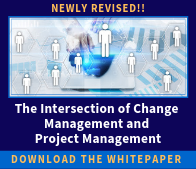While many organizations include some of the necessary people-side project management deliverables some of the time, it’s not a consistently-applied change management consulting process. As a result, implementation success is spotty. While attempts are made to either “bolt on” a human “change management” plan at the end of the technical plan, or to run a human plan in parallel, the best practice is a blended plan. 
Tips for Developing an Integrated Change Management Consulting Plan
At a minimum, the blended plan should include the following elements and deliverables of the Accelerated Implementation Methodology (AIM) change management methodology:
Defining the Change:
How will we develop a common definition of the change, and how will we identify the new behaviors we seek to see in the future state in observable, measurable terms? The first deliverable is a clear and compelling Business Case for Action that should be developed very early in the project lifecycle. The Business Case for Action answers these questions:
- What are we changing?
- Why are we changing?
- What happens if we don’t succeed?
Tip: This change definition needs to be translated into the Frames of Reference for the various target groups so that it is positioned from their perspectives, not from the perspective of management. A solid change definition provides the foundation for building organizational alignment around a common definition of the change.
The Sponsorship Strategy:
A robust key role map is one of the most valuable AIM deliverables and is integral to the Sponsorship strategy. The key role map is more than just a general stakeholder analysis; it is a visual depiction of the precise organizational location of Authorizing Sponsors, Reinforcing Sponsors, Change Agents, and Targets of the change. While it may take several weeks of change management consulting to develop a good key role map, it is an invaluable tool and provides the project team with significant insights into what level of resources will be needed to develop a cascading network of Reinforcing Sponsors at the local implementation level of the organization.
Tip: Use the key role map to identify where you will need sponsors. Remember that every resource must be sponsored. That means every change agent must have Sponsorship.
The Readiness Strategy:
The AIM Individual Readiness Assessment tool helps the project team identify the likely sources of resistance so that tactics and strategies can be deployed to shorten the duration and depth of the resistance. The data enables the team, Change Agents, and Sponsors to understand how the change is perceived from the Frame of Reference of the Targets. A Readiness Strategy should be built into the project plan as a way to measure the progress of adoption of new behaviors.
Tip: Building readiness is not a check-the-box activity. The sources of resistance will be different at the beginning, middle and end of the project, so you will need to deploy different strategies and tactics. For longer projects, you will likely need to conduct the Readiness Assessment more than once.
The Reinforcement Strategy:
Every best practice project plan should include a Reinforcement Strategy that helps Sponsors and Change Agents apply immediate and certain behavioral reinforcement at the local level for the implementation-specific behaviors we seek to see for that change. The “menu” of formal and informal reinforcements should be developed from the Frame of Reference of the Targets. Note that the formal performance appraisal process is insufficient because it is too infrequent.
Tip: The more often you measure the new behaviors you are seeking, with positive and negative consequences attached, the faster you will achieve adoption of the changes. If there is no behavior change, there is no change--and reinforcement is the driver of the behavior change!
The Communications Plan:
Many project plans do include a Communications Plan, but the plans are focused on top-down information sharing with no opportunity for feedback from the message recipients. The Communications Plan should use a variety of delivery vehicles and varying messages that take into account the Targets’ Frames of Reference.
Tip: Communications is not just a top-down activity. Every message should include a “feedback loop” for gathering information that is fed back to the team, Sponsors, and Change Agents. This feedback loop is essential for identifying the sources of resistance to the change.
Each of these important elements and deliverables is addressed by our change management consulting using the AIM change management Methodology. By following the principles of AIM in your next project plan, you can dramatically increase your probability of implementation success.


